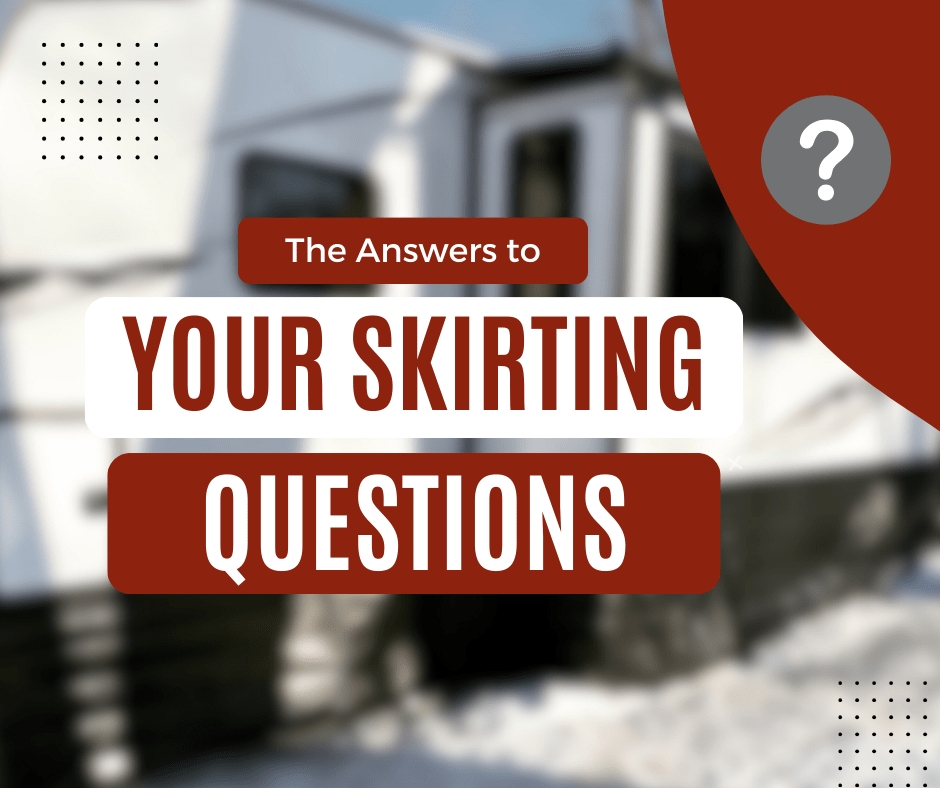Thinking about braving the winter in your RV or Tiny Home? Then RV skirting might be your new best friend. But what exactly is it, and is it worth the effort? Let’s answer some of the most common questions RV owners have about skirting.
Why Skirt Your RV or Tiny Home?
Imagine a cozy sweater for your RV’s underbelly. That’s essentially what skirting does. By creating an insulated barrier around the bottom of your RV, skirting traps warm air in and keeps the cold out. This translates to several benefits:
- Freeze Protection: Skirting shields your pipes and tanks from the harsh winter bite, preventing them from freezing and potentially bursting.
- Energy Efficiency: Less cold air sneaking in means your heater doesn’t have to work as hard to keep you toasty. This saves you money on propane and reduces your environmental impact.
- Year-Round Comfort: Skirting isn’t just for winter! It can also help regulate temperatures in warmer months, keeping your RV cooler and more comfortable.
- Creature Comforts: Skirting acts as a barrier against unwanted pests like critters and crawlies seeking shelter under your RV.
Is Skirting Expensive?
The cost of RV skirting depends on the material you choose. Here’s a quick rundown:
- Budget-Friendly: Vinyl skirting is a popular choice for their affordability and ease of installation. We offer this standard skirting as an 18oz 22mil PVC coated vinyl.
- Mid-Range: Insulated skirting offers superior protection against cold weather but comes at a slightly higher price point. Our company is known for its Insulated RV Skirting and at a great price point.
- DIY Options: Feeling crafty? Foam panels or even plywood can be a cost-effective option if you’re handy with tools. You can also get our vinyl skirting or insulated skirting as a DIY Kit. Take a look at how easy it is to install by watching our installation video: RV Skirting DIY Kit
Finding the Right Material:
The best skirting material for your RV depends on your climate and priorities. Here’s a cheat sheet:
- Cold Climates: Insulated skirting or heavy-duty vinyl are your best bets for maximum warmth retention.
- Moderate Climates: Standard vinyl skirting offers a good balance between affordability and insulation.
- Warm Climates: Lighter weight vinyl or even skirting alternatives like wind blockers might be sufficient.
Can I Install Skirting Myself?
Absolutely! Many skirting materials, particularly vinyl kits, are designed for DIY installation. They typically come with clear instructions and require minimal tools. However, if you’re not comfortable with the process or prefer a more custom solution, hiring a professional is always an option.
Skirting Alternatives?
While traditional skirting is the most common approach, there are a few alternatives to consider:
- Hay Bales: A budget-friendly option, but hay bales require regular maintenance and can attract critters. They also do not seal up completely and leave plenty of gaps for the warm air to escape.
- Snow Skirting: In areas with consistent snowfall, some RVers strategically pile snow around the base of their RV for insulation (not recommended for areas with unpredictable snowmelt).
Stay Cozy, Save Money, and Enjoy the Road!
RV skirting is a worthwhile investment that can significantly improve your RVing experience. By keeping your RV comfortable year-round and protecting your pipes from freezing, skirting helps you save money and extend the enjoyment of living in your RV. So, choose the skirting solution that best suits your needs, and get ready to conquer any season in comfort!
About Us:
Here at The Skirting Company, we’re passionate about the RV lifestyle and helping you stay cozy in the winter. Our team of experts is dedicated to providing you with valuable tips, guides, and high-quality products to make your camper living experience even more enjoyable.
